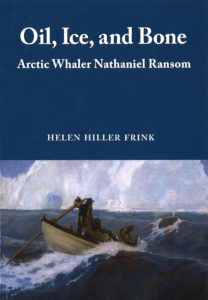 By Helen Hiller Frink, Peter E. Randall Publisher, Portsmouth, NH (2015)
By Helen Hiller Frink, Peter E. Randall Publisher, Portsmouth, NH (2015)
Reviewed by Ingo Heidbrink, Ph.D.
In her book Oil, Ice and Bone, Helen Hiller Frink describes the whaling voyages of Nathaniel Ransom. She begins with his first journey as a fourteen year old boy in 1860 and culminates with the 1871 disaster in which most of the North-Pacific whaling fleet was lost. In his final cruise, thirty-three whaling ships were either crushed by the ice or abandoned by their crews.
Nathaniel Ransom’s diaries were the main source for this book. These first-hand accounts of the various journeys offer a close look into the everyday routine onboard New England whaling ships and the wider whaling community of the mid-19th century. While it is always a pleasure to learn about this important period of American maritime history, it must be asked if Oil, Ice and Bone offers something that has not already been described in the existing body of related literature. Hiller Frink’s book manages to tell an interesting story, depicting whaling as both a series of both heroic hunts and long stints of routine without sight of a whale for weeks. Hiller Frink’s book does not bring much new information to the table, but successfully articulates a personal perspective of everyday life on a whaling vessel.
Oil, Ice and Bone depicts the composition of the crews’ interactions with one another, making obvious the strains of the international industry and differences among crewman of different nationalities. He successfully describes the often-overlooked fact of poor crew retention, as very few ships returned to their homeports. Her description of Ransom’s ability to court his future wife despite being at sea for the majority of a year provides a unique insight into private relations long before the age of global connectivity. Consequently, this book deserves high praise and will definitely result in a better understanding of the men working in this past industry.
There are also a number of weak points, most notably the absence of a transcript of the original diaries. Hiller Frink has chosen to use the original source text for narrating a single coherent story in her own words rather than commenting on the original text. Her approach results in an increased readability for the general public, but leaves the professional historian somewhat unsatisfied. There is no chance to revisit the original source material or to use the diaries as material for questions outside the focus of Hiller Frink’s book. Nevertheless, a brief but well selected bibliography provides other contemporary whaling diaries and journals. These can help the professional historian to identify the materials relevant for future research into the American whaling industry of the 19th century.
This book is a welcome addition to the bookshelves of any reader interested in the history of the U.S. whaling industry. While it lacks analytical depth, the book remains a successful narrative of those who worked in this industry.
For historical research, this book lacks source material. For everybody else, this book will be an interesting read, as it provides an insight into an industry once among the most relevant of maritime industries of the U.S. More importantly, this book offers insight into the everyday life of people related to the whaling industry, which has recently regained a good deal of public interest. The recent growth in public interest is due to the discussion to end commercial whaling and the recent successful 38th voyage of the 19th century Charles W. Morgan, the only surviving U.S. whaling vessel.
Ingo Heidbrink teaches history at Old Dominion University.

